Cordless Reciprocating Saw Head to Head
BEST Cordless Reciprocating Saws – Head-to-Head
One of the most widely used power tools in the construction industry would be the reciprocating saw. The first reciprocating saw was introduced by Milwaukee in 1951 with their SAWZALL® Reciprocating Saw. Today, over 65 years later, we find the industry filled with full-size cordless reciprocating saws used on millions of projects on a daily basis. Users include demolition contractors, plumbers, electricians, carpenters, mechanical contractors – in both residential and commercial industries – and even firefighters. Next to the drill, we can’t think of a power tool that touches so many different trades.
In our latest head-to-head, we invited tool manufacturers to send us their top-of-the-line cordless reciprocating saw that utilizes a single battery in the 18 to 22 volt arena. There are other larger voltage reciprocating saws out there (Makita has a 36V, which takes two 18V packs), and DEWALT has the 60V FlexVolt version), but we wanted to keep the group of tools at least in the same general voltage category.
The entire Tool Box Buzz crew, which is comprised of guys who cover the gamut of typical reciprocating saw users, participated in the test. Our colleague, Chris Ermides, (Editor at Tool of the Trade and Senior Editor at JLC) also participated as a guest tool-tester.
Cordless Reciprocating Saw Lineup
The following brands and models were tested in this head to head. They include:
- Bosch GSA18V-125K14
- DEWALT DCS367P1
- Hilti WSR 22-A
- Hitachi CR 18DBL
- Makita XRJ05
- Metabo ASE 18 LXT
- Milwaukee 2721-20
- Porter-Cable PCC670
- Ridgid R8643 – This is a new tool that’s due to be released in the first quarter or 2018
- Ryobi P517 – This is a new tool that’s due to be released at the end of 2017
Cordless Reciprocating Saw Specifications
We’ve listed the basic specifications for these tools, a link to their web page, and the batteries that were used in the test.
- Bosch GSA18v-125k14: Brushless Motor, 18V Lithium Ion 6.3 Ah CORE Battery, 1-1/4″ Stroke, 0-2,500 SPM, 7.7 lbs, Hard Plastic Case, Fast Charger
- DEWALT DCS367P1: Brushless Motor, 20V MAX 5.0 Ah Lithium Ion Battery, 1-1/8″ Stroke, 0-2,900 SPM, 5.0 lbs (bare tool weight), Soft Zipper Bag, Charger
- Hilti WSR 22-A: Brushed Motor, 22V Lithium Ion Battery – We tested with the 5.2 Ah battery packs, 1-1/8″ Stroke, 0-3,000 SPM, 8.4 lbs, Soft Zipper Bag, Compact Charger
- Hitachi CR 18DBL: Brushless Motor, 18V Lithium Ion Battery – We tested with the 6.0 Ah battery packs, 1-1/4″ Stroke, 0-2,500 SPM, 7.5 lbs, Hard Case, Battery Charger
- Makita XRJ05: Brushless Motor, 18V Lithium Ion Battery – We tested with the 5.0 Ah battery packs, 1-1/4″ Stroke, 0-3,000 SPM, 8.2 lbs, Hard Case, Battery Charger
- Metabo ASE 18 LXT: Brushed Motor, 18V Lithium Ion Battery – We tested with the 6.2 Ah battery packs, 1-3/16″ Stroke, 0-2,700 SPM, 7.9 lbs, Soft zipper bag, battery charger
- Milwaukee 2721-20: Brushless Motor, 18V Lithium Ion Battery – We tested with the 5.0 Ah battery packs, 1-1/8″ Stroke, 0-3,000 SPM, 7.4 lbs, Hard Case, Battery Charger
- Porter Cable PCC670: Brushed Motor, 18V Lithium Ion Battery – We tested with the 4.0 Ah battery packs, 1″ Stroke, 0-3,000 SPM, Not kitted
- Ridgid R8643: Brushless Motor, 18V Lithium Ion Battery – We tested with the 6.0 Ah Blue Tooth battery packs, 1-1/8″ Stroke, 0-3,200 SPM, Not kitted
- Ryobi P517: Brushless Motor, 18V Lithium Ion Battery – We tested with the 4.0 Ah battery packs, 7/8″ Stroke, 0-3,100 SPM, Not kitted
Head-to-Head Testing / Evaluation
For this Cordless Reciprocating Saw Head to Head we wanted to develop several speed tests relevant to several core trades. We developed tests we felt would resonate with the following users:
- Plumbing/heating contractors
- Electricians
- General construction/demolition.
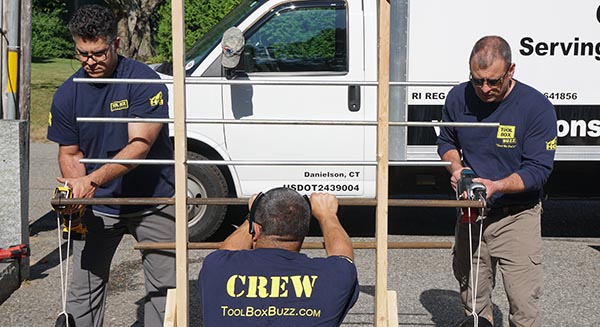
The tests that we developed included:
- 3/4″ Gas Pipe – This test is relevant specifically to plumbing and heating contractors. We used new 6″ Lenox 14TPI blades designed for thick metal in each saw and took the average time for 5 cuts.
- 1/2″ EMT Conduit – In this test we simulated a task that electricians perform on a regular basis. We used new 6″ Makita 14TPI industrial bi-metal blades in each saw and took the average time for 5 cuts.
- Nail Embedded Wood – Here we nailed four (4) 2×10 joists together and then installed five (5) 16d nails in each 2×10 for a total of twenty (20) nails. So for each cut we plowed the blade through four nail-embedded 2x10s. This simulates heavy-duty demolition cutting for carpenters, remodelers and general contractors. We used a new 9″ Milwaukee AX carbide-toothed 5TPI blade designed for nail-embedded wood in each saw and took the average time for 5 cuts.
In an effort to obtain similar cutting pressure applied to each saw we hung a 10 lb weight from a rope situated on the forward grip of each reciprocating saw. Testers started the cut with both hands on the saw, then released the front hand to allow the 10 lb weight to pull the blade through the cut. This method was used for all the tests.
Also, some of these saws include a variable speed option. We performed each of these speed tests at the highest speed setting. The Milwaukee One-Key® allows users to adjust the speed settings on the saw. We performed the tests using the highest factory applied speed setting.
Cordless Reciprocating Saw Test Results
3/4″ Gas Pipe Testing Results – Winner: Milwaukee 2721-20
As you can see from the results Milwaukee produced the fastest average cut speed of 3.7 seconds followed by Makita at 4.2 seconds and Ridgid at 4.4 seconds. The leaders are around twice as fast as the back of the pack and much faster than the Hilti.
It should be noted that the three slowest saws in our test all use brushed motors, which is older technology, whereas the fastest seven all use brushless motors, which is the latest technology. Hilti was a bit of a surprise to us, so we inquired about the results with Hilti, they told us that this model is a much older saw; it hasn’t been updated in quite some time compared to the field of brushless models we tested.
1/2″ EMT Conduit Testing Results – Winner: Milwaukee 2721-20
Milwaukee finished in first place again with an average time of 0.61 seconds followed by Bosch at 0.65 seconds and Ridgid, with an average time of 0.71 seconds. There was a clear difference between the top five tools and the bottom five for this test.
Nail-Embedded Wood Testing Results – Winner: Milwaukee 2721-20
Milwaukee won this test with an average cut time of 36.6 seconds followed by DEWALT with 37.8 seconds and Ridgid at 42.3 seconds. Metabo, Ryobi and Porter-Cable all failed to make 5 cuts due to thermal overload on the tools – a built-in “switch” meant to protect the tool from long-term damage. Metabo managed to make 4 cuts with an average of the four at 67.9 seconds. Ryobi only managed 2 cuts with an average of 70.2 seconds, and Porter-Cable only made one cut at 84.6 seconds. This test shows us that these last 3 tools are not able to sustain extreme demolition tasks similar to this test.
Test Results Compared to Published Specifications
When we do our head-to-head testing we often get questions about the actual tool performance compared to published “specifications”. For this article, we wanted to look at how these cordless reciprocating saws performed compared to their published results. Reciprocating saws have two major variables; speed (strokes per minute), and stroke length (distance the blade travels). Theoretically saws that go the fastest and have the furthest blade travel should cut material quicker than saws with lower values. For this assumption to hold true, the saws would need to have the same power output from the motor.
Below is a chart showing the Stroke Length in inches multiplied by the Stroke Speed in strokes per minute to define the Total Stroke Length per minute. One very important note about this chart; the speed of the saw is from published data for no load on the tool (in other words no pressure from cutting material).
The next chart shows the total ranking of the 3 tests we performed. This was calculated by adding up all the scores for all three tests. Milwaukee got a score of 3 because it placed 1st in each test (1+1+1=3). The lower the total score the better the tool did overall in the three tests. This is just a relative ranking to show how they did on speed tests.
If you were to rank the tools based on the published numbers, the top three performers for cutting speed should have been Makita, Ridgid and Hilti. However, in our testing the results were quite a bit different. The clear winner in our testing was the Milwaukee followed by the Ridgid, and then a three way tie for third place between Bosch, DEWALT, and Makita. Probably the most surprising tool in the group was the Hilti that tied for 6th place with Ryobi.
It’s very important to note that we only performed 3 different tests and there are arguably thousands of tests you could perform on reciprocating saws and those results would vary from ours. But what is important is realizing that the published specifications on a tool don’t always result in the same performance when used on the job site.
Our take away from this data is how important the motor is on the final performance. Clearly the brushless motors had a big advantage over the brushed motors. With the brushless motors comes the need to electronically control them and it’s clear the Milwaukee saw has a great combination between the motor, battery, and electronics.
Cordless Reciprocating Saw Ergonomics
The ergonomics of power tools is vitally important to performance and user productivity. We ranked the top three saws with regards to ergonomics from comments provided by our group of testers after using the tools during the tests above. We included both positive and negative comments that are very subjective but important in any comparison. The group evaluated the size, configuration, weight, balance, grips, blade changing and other features for the top three tools.
- Milwaukee 2721-20– The Milwaukee saw was the most powerful and fastest of the saws tested. The group liked the easy-to-see LED fuel gauge placement on the battery and the ease of battery removal and installation, although a few testers commented that the push button might be hard to use with a glove. The front over-mold was well-liked and the vibration felt by the operator on the Milwaukee 2712-20 was less than most of the saws tested. The Milwaukee is the only saw to provide the unique One-Key® smart phone application to monitor its location and performance. A few testers commented that the blade release was hard to use, needing two hands. The rafter hook and shoe adjustment mechanism rated very favorable comments.
- Rigid R8643 – The testers commented that the over-mold on the front of the Rigid saw was the best fitting, most substantial of all the test units. The blade release is a two-hand operation with a twisting action and was graded down in comparison to other, easier blade releases. The unit weight was often brought up as being one of the heavier units tested. Despite its weight, the tool felt the ergonomically balanced unit when using it with two-hands. The variable speed trigger and the vibration were rated as a positive features. The vibration was less than at least 50% of the units tested. The group felt that this tool could use a rafter hook to complete its feature offering.
- Makita XRJ05 – This saw had features that were well liked and some that were equally disliked. The blade changer drew universal praise for its stay-open-after-the-blade-removal twist lock feature that made blade replacement the easiest of all tested saws. The blade changing is assisted by a spring ejection feature. On the other hand, the over-mold was observed to be less comfortable and less quality than most other units. The Makita RXJ05 was a well-balanced saw and includes a rafter hook. Many reviewers were not fans of the LED fuel gauge placement being out of easy sight by the operator.
It’s also worth noting that both the Bosch and DEWALT models are significantly different in size and shape compared to traditional reciprocating saws. Both of these saws are compact and designed to get into tighter locations. The Bosch was extremely smooth with minimal vibration.
Cordless Reciprocating Saw Costs and Value
It’s always hard to compare the pricing of cordless tools especially when each manufacturer packages them differently with kits, bare tools, and then varying size batteries.
- Bosch GSA18V-125K14: This was a kit with one battery, and a hard case. We added a second battery to this for a total price of $527 ($399 kit plus $128 for additional battery).
- DEWALT DCS367P1: This was a kit with one battery, and a soft zipper bag. We added a second battery to this for a total price of $378 ($279 kit plus $99 for an additional battery).
- Hilti WSR 22-A: This was not a kit, this included the tool, a soft zipper bag, two batteries and the charger for a total price of $490 ($179 tool, $133 each battery, and $45 for the charger).
- Hitachi CR 18DBL: This was a kit in a hard case with one 6.0 Ah battery, but it’s not available on the market quite yet. The MSRP will be approximately $408 ($300 for the kit, $108 for an extra battery)
- Makita XRJ05: This was a kit in a hard case and two 5.0 Ah battery packs with a charger. This kit is priced at $408.
- Metabo ASE 18 LXT: This tool came as a tool only in a soft bag, we added two 6.2 Ah battery pack and a charger for a total price of $498 ($178 for the tool, $133 for each battery and $54 for the charger).
- Milwaukee 2721-20: This kits comes with a soft bag, two 5 Ah battery packs and a charger for $449.
- Porter-Cable PCC670: This tool comes as a bare tool only, we added two 4.0 Ah battery packs and a charger for $216 ($50 for the tool, $64 for each battery and $39 for the charger.
- Ridgid R8643: – This is a new tool that’s due to be released in the first quarter or 2018. We’re estimating the total cost to be $486 ($149 bare tool, $129 for each 6.0 Ah battery pack, and $79 for the charger). It’s very likely this tool will be included in a kit that makes it far more affordable when it’s finally released.
- Ryobi P517: This is a new tool that’s due to be released in the end of 2017. We’re estimating the total cost to be $278 ($119 bare tool, two battery packs for $119, and $40 for a charger).
When it comes to pricing and value we have to rank the DEWALT DCS367P1 the best value. This saw tied for 3rd place in our performance testing and finished just outside the top three in ergonomics. Priced under $400 this is the best value for anyone looking for a contractor grade cordless reciprocating saw. Honorable mention needs to go to the Hitachi CR 18DBL priced at $300 considering it finished in 4th place for the performance testing. For the home owners we’d highly recommend the new Ryobi and expect it to show up in really affordable kits once it’s on the market.
Overall Winner – Best Cordless Reciprocating Saw
First Place – Milwaukee M18 FUEL™ SAWZALL® Reciprocating Saw w/ ONE-KEY™
The best Cordless Reciprocating Saw is hands down the Milwaukee FUEL 2721 with One-Key®. This reciprocating saw dominated the playing field and maintains it’s legacy as the SAWZALL. This cordless recip saw is every much as powerful and fast as it’s older corded models and offers technology that makes it even more versatile than ever. The ability to match blade speed to the cutting application sets this tool above all the competition. This combined with it’s awesome performance and compatibility with an extensive line of M18 tools make it the easy winner.
Second Place – Ridgid 18V Brushless Reciprocating Saw
The real surprise for our testing team was the Ridgid R8643 18V Brushless Reciprocating Saw. This is a brand new saw that hasn’t hit the street yet but it is a beast and sure to make a huge impact for Ridgid. Not only did it clearly finish in 2nd place in our performance testing, but it also finished in 2nd for ergonomics. While the pricing seems high for a Ridgid tool, this has to do with using suggested retail pricing, pairing it with 6.0 Ah battery packs that will likely get sold for less money in double packs at some point, and the fact that it’s not currently available in a kit. We have a feeling the pricing will be down around $300 once this gets rolled out.
Third Place – DEWALT 20V MAX* XR® Brushless Compact Reciprocating Saw
Third place was really difficult and close. For us, the fact that this is a compact design, and how well it did in the demo testing combined with its great pricing edged it over the Makita ever so slightly. Priced at just $378 for this kit, with solid performance this is a kit that’s tough to ignore. While the new “compact” design may leave some guys scratching their heads, the proof is in the pudding so to speak and this saw doesn’t disappoint.
Final Thoughts – Cordless Reciprocating Saw Head to Head
65 years ago Milwaukee released the first SAWZALL and today they are still the king of reciprocating saws. The Milwaukee FUEL M18 2721 Reciprocating Saw with One-Key® ran away with this competition. It performed better than the rest of the tools and offered the best ergonomics.
The top 5 cordless reciprocating saws (Milwaukee, Ridgid, DEWALT, Makita and Bosch) are all excellent options and any of them would be a great addition to your tool box, especially if you’re already in that battery platform.
The big take away from this testing is the fact that most of these cordless reciprocating saws perform at a level consistent with older corded reciprocating saws. Cordless reciprocating saws have finally cut the cord and we can all benefit from that! If you haven’t bought one yet, it’s time to cut that cord and free yourself to move about the job site with ease!
Cordless Reciprocating Saw Head to Head Video Review
About the author
35 Comments
Leave a comment
Disclosure
Product reviews on this site contain our opinion of a product or service. We will always strive for objectivity and transparency in our reviews. Our goal is to provide readers with honest, objective information based on our own experiences. We never have and never will accept payment in exchange for a positive review. Many of the products that we review are provided to us for free by a manufacturer or retailer. In some cases, we also have advertising or affiliate relationships with manufacturers and retailers of products and services we review. For additional information please visit our additional disclosure policies.











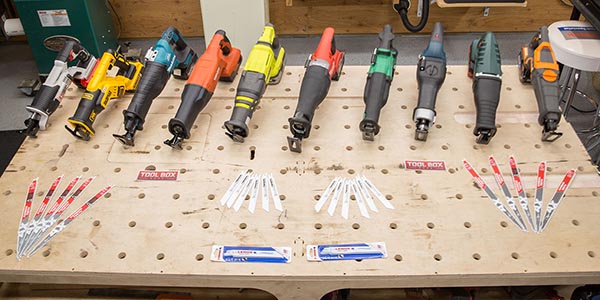
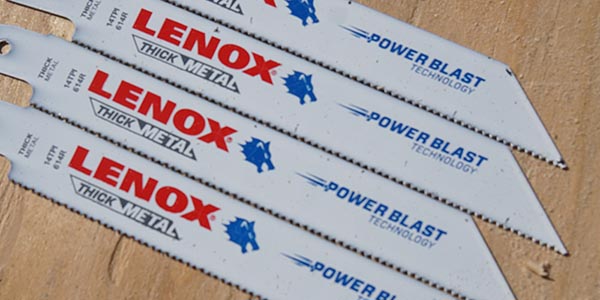
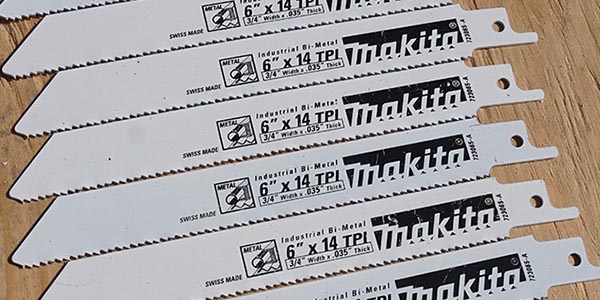
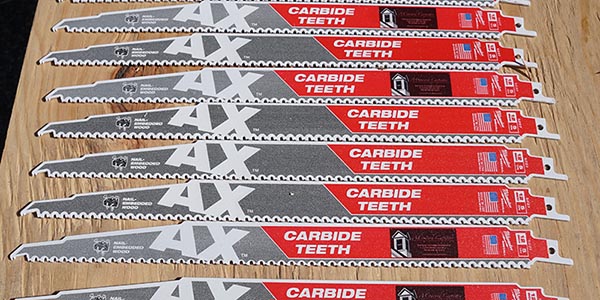
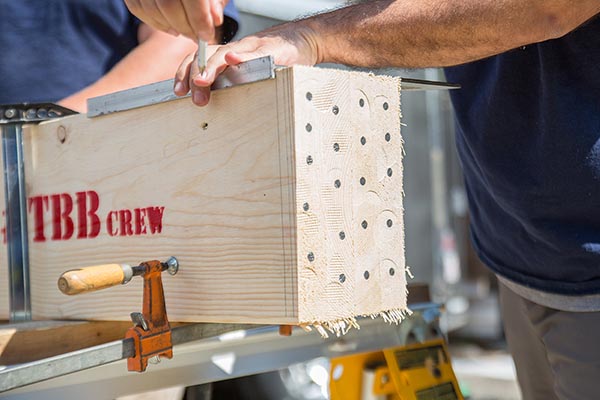
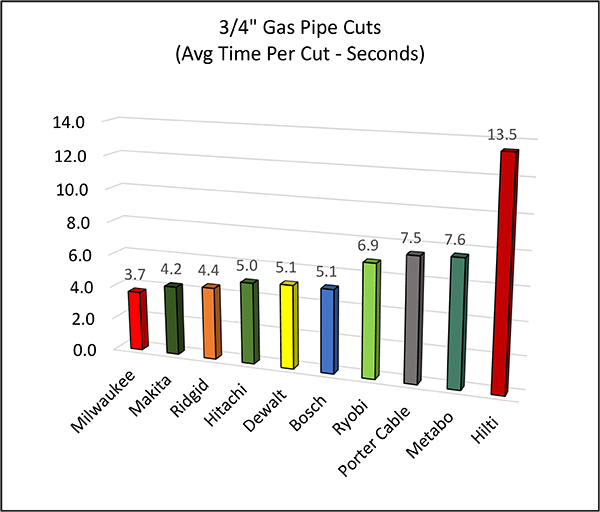
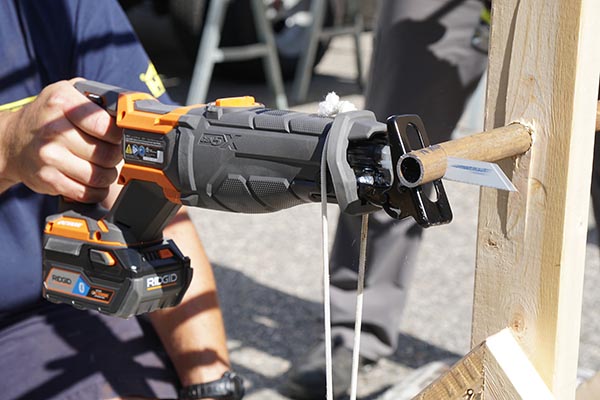
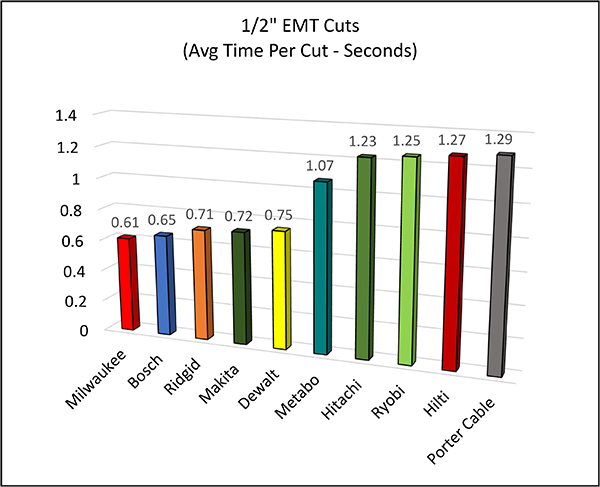
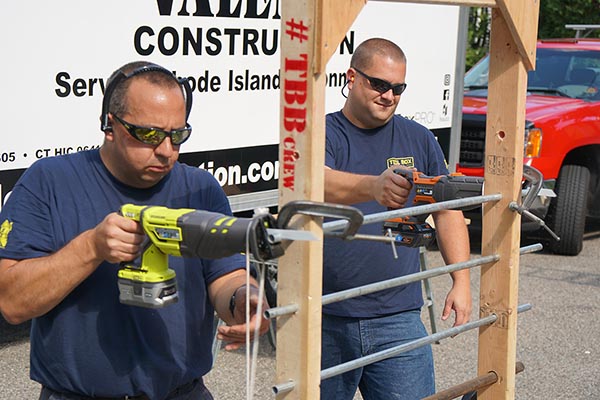
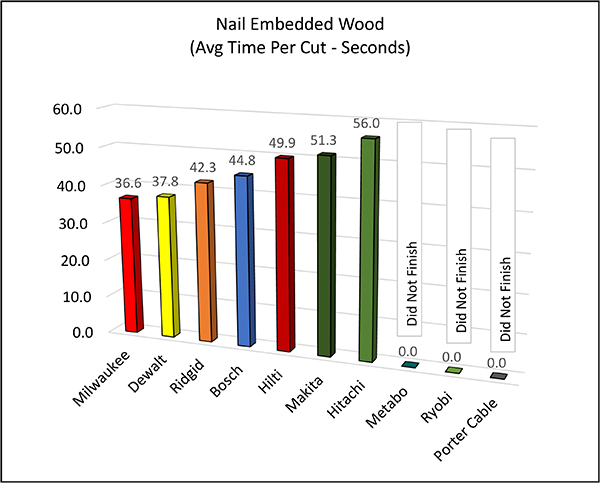
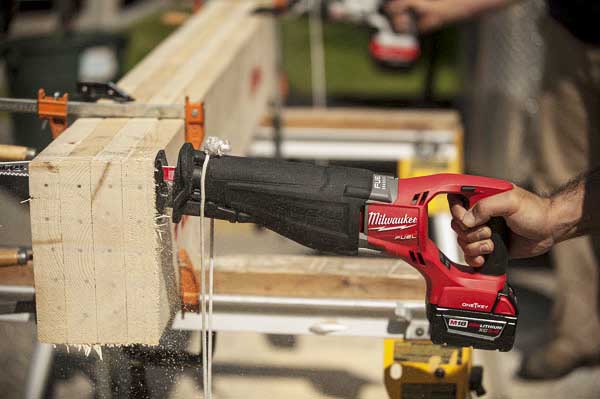
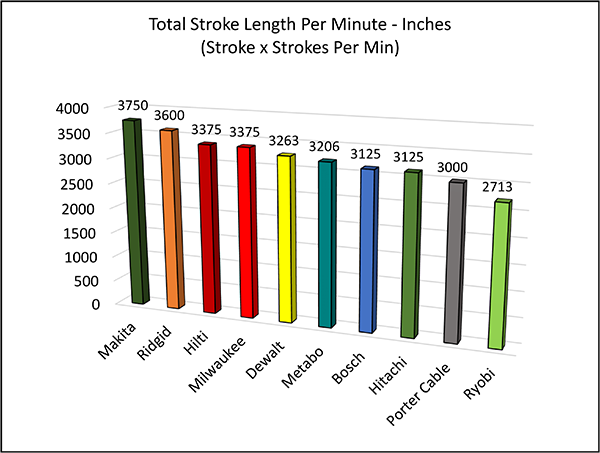
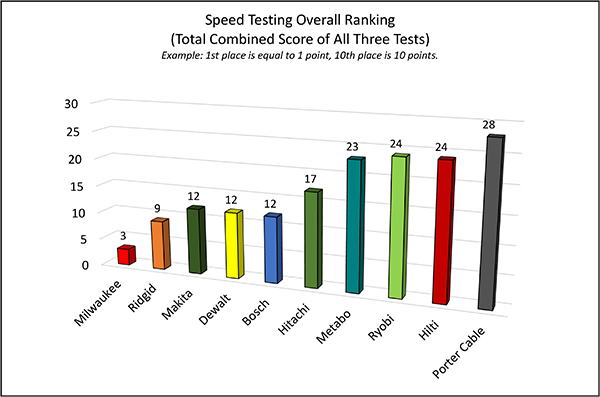
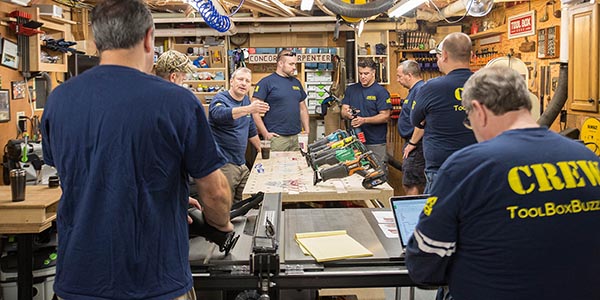
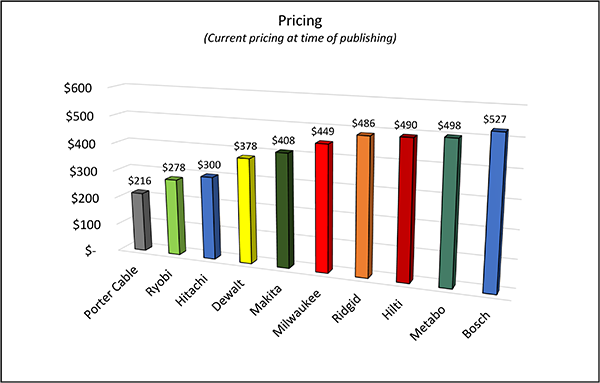
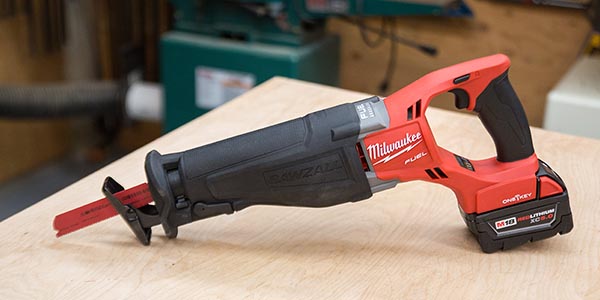
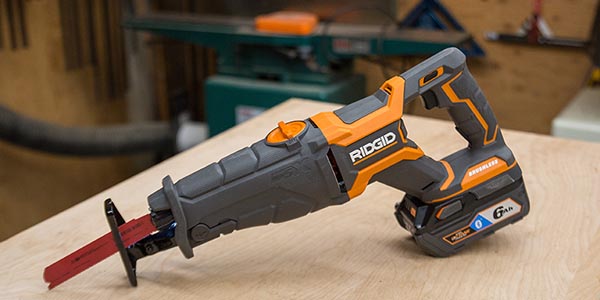
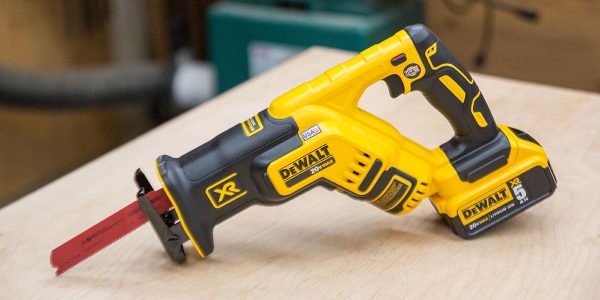
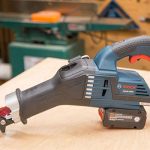
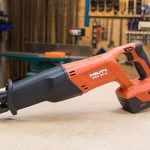
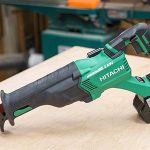
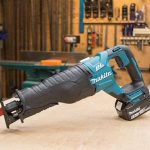
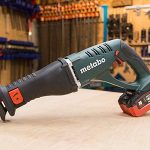
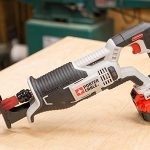
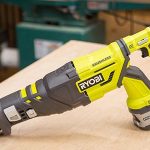
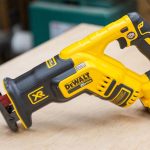
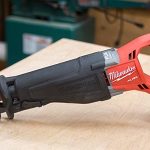
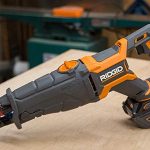
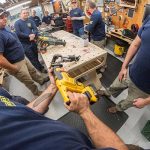
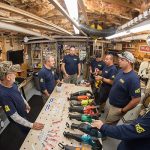
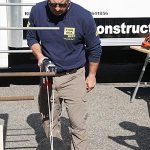
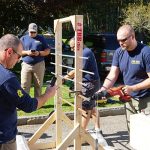
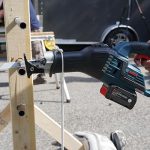
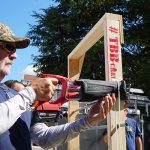
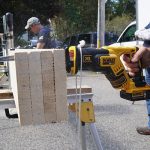
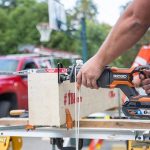












Wow that is a disappointing result for the HILTI. Love ours.
Did they say if they had a brushless model in the works?
To have the HILTI tied with the ryobi isn’t really fair if the ryobi
DNF in the nail embedded nail test. Pretty embarrassing for HILTI
to have a worse time in the other 2 events
Dan – It’s not a horrible recip saw, our testing focused on speed and in that the Hilti is much slower than the competition. We just visited Hilti last month and while they didn’t show us anything new, they seemed to imply that an update on some of the older tools was in the works. As I said in the article, this was just a few tests in thousands that could be done. The Hilti is certainly built to withstand lots of heavy commercial use and that’s important as well.
Except that the test was flawed, obviously the Ryobi overheated because the 10 lb weight hanging from it was too much for a weaker tool. Similarly you can take any tool that’s a little wweaker and have problems if you’re too ham-fisted to recognize that a lesser tool is supposed to take longer.
With any of these you could reproduce the result, just keep hanging more and more weights on the slower tools until they overheat and so on with more weight on the next slowest. All it proves is how mindless the test was instead of just putting it in someone’s hand that can use a little common sense.
On the other hand, the faster tools might benefit from even MORE weight added. This is nothing new, we all already intuitively knew you don’t push a homeowner grade tool as hard as a contractor grade if you want it to last.
it’s a fair test. As fair as they can replicate. Theirs so many ppl bitching that theirs a better way to compare the saws… well, knock yourself out. Post the results. YouTube, Facebook, Ig, Twitter and all the other sites are free to everyone. Anyone that takes the time to show me real world results of tool use is much appreciated. Thanks guys!
For the cost I like ryobi… Its something I can replace easily and still does it’s job.. I used to be a team type person and favored makita… But ater having a truck stolen and gutted… My main focus is on the tools I operate tot the ones with a battery.
Who ties a 10 lb weight at work to their saw and than watches the saw cut? Nobody. Trying t9 be too fair. What saw cuts the best or fastest when pushed hard? Or just by an actual carpenter not a weight. This testing is ridiculous. Sorry t9 call it as I see it.
You’re certainly entitled to your opinion. We did this to remove as much bias as possible. Sure, no one cuts this way. But when trying to compare several tools as fairly as possible, this makes huge sense.
No Todd it doesn’t make sense, if you add so much weight that some don’t finish the test. That’s called an excessive amount of weight and if someone on a jobsite was pushing ANY of these tools so hard that they overloaded and thermally cut out, that guy is called an idiot who can’t use the power tools because we want them to keep working. He gets to do mundane trips to the truck, sweep up, carry lumber, or go get lunch for us or something instead of breaking things.
Dave – We’ll agree to disagree. This test is done by most of the tool companies when demonstrating their recip saws at the events we attend. 10 lbs isn’t a crazy amount of weight, and it allows us to show how the perform under a similar loading condition. While you may think this is a narrow test we feel it’s quite appropriate and provides a very good fair comparison. Let’s not forget we all tested the saws without weights and found similar results.
dave: “if someone on a jobsite was pushing ANY of these tools so hard that they overloaded and thermally cut out, that guy is called an idiot”. Please consider the following: the operator (the “idiot” you are referring to) will have to first learn from his own tests how much pressure he can put on the tool before knowing its weakness. Well, the excellent test report here is telling the potential operator which tool can be pushed hard and which can’t. From this test one can learn which sustain heavy duty work and which don’t, preventing one from becoming an idiot.
By adding a fixed weight to replace the downward force of the operator, the test eliminates most of the human bias (the tool tester). It is scientific in the sense that it is reproducible. It does make a huge amount of sense. Also note that for the weak tools, the article does explain in details how these tools behaved.
As far as cutting speed is concerned, the test is as objective as it can be.
Excellent job guys!
Thank you Ludo….we try to show all the data so users can make their own assessment based on their needs and potential uses.
I differ. What you tested was how fast the saws cut with a 10 lb weight. Why no 5,15,20. Or all weights. A good carpenter or craftsman will find the power or sweet spot of any given tool and work to this.
Your tests just look the corporate advertising the tool company do to showcase why their tools are better than anybody else’s. ie it’s not real world. Just my 2 cents.
Point taken. I’ll just say this, we spend a ton of time doing this, not for the tool companies, but to try and give guys an idea of how the tools stack up. We’re not a testing lab, and we don’t have unlimited time and resources, pretty hard pressed to find anyone providing the testing data we provide on other sites.
And if TBB didn’t do the tests with a 10 pound weight, I bet you’d be whining that they could have leaned harder on their favorite tool. Give them a break, they are trying to be as unbiased as possible in their test methodology.
Doresoom, “trying to be as unbiased as possible” is a nice gesture, but it’s the result that counts. Achieving unbiased would mean you don’t strap weights on unless you are willing to go to the next level of trying an appropriate level of weight.
If you really feel someone is going to play favorites, it would have been better to blindfold the users, but being sure to pick some that aren’t mentally challenged so they don’t go and cut their fingers off from lack of knowing how to use a sawzall.
Well. My suggestion would save time. Just get out there and use the tools and not hang weights off of them. Didn’t mean to touch a nerve but if your only looking for praise why do it ?
Glass your suggestion was entirely appropriate because in actual real world use, we aren’t going to be hanging 10 lb weights on them. An artificial test that deviates from real world use this much, cannot predict real world use as well as a lesser deviation from it.
Although they haven’t been released yet, a 2 pack of the Ridgid hyper octane 6.0ah Bluetooth batteries showed up on home depot’s website in March for $159. Shortly thereafter they disappeared from HD’s website and I would imagine they won’t be back up until the official release time
https://www.ridgidforum.com/forum/power-tools/power-tool-discussion-forum/715684-6ah-batteries
I would like to have seen the dewalt 60V sawzall in the lineup of the test versus the Milwaukee. I’ve been debating between dewalt and milwaukee for my next sawzall.
The best saw is the one that fits your batteries. I needed a new reciprocating saw and all my stuff is Dewalt so I was about to buy a bare tool for $119 at Lowes but ended up getting a bag kit with the 20 volt saw, drill, nut driver, LED flashilight, charger, 2 batteries for $247 new on ebay.
I really love all my Ridgid tools, but if I wasn’t so heavily invested in them I would seriously get into the Milwaukee sets. I have the 12V Milwaukee set that I use for work every day running wall plates and such. GREAT videos guys and I look forward to seeing each new one.
I’m really curious as to why there are different rankings of models in the different tests.
For example, what would cause the Makita to finish 2nd in the pipe test and 6th in the nail embedded wood test. Or Bosch 2nd in the conduit test, but 5th in the pipe test. Seems strange.
It’s the speed of the cut. Each of these saws is cutting at a different rate with a different motor. So it’s possible that for each cut (these will require different amounts of power, and the base cutting material is different, speed of the blade is important to how it cuts) that each saw responds differently. This is not unusual at all.
Did you use the orbital setting on the Ryobi for the nail embedded wood test?
Yes we did.
I own the new brushless Bosch and its amazing. My coworker is so jealous of me and he owns the Milwaukee Fuel. The fuel isn’t a bad saw but no way it keeps up with the Bosch on any material. The new Core batteries make a huge difference compared to the old regular 18V. Nice test but from using both saws on the field I prefer the ergonomics and power of the Bosch.
Interesting…what are you cutting? We found different results in our tests, and we also use them in the field.
You found the wrong results because the new Bosch has more power than the older Milwaukee so the Bosch can be pushed harder than the 10lbs. That’s why the compact dewalt did so well. It’s sweet spot is 10lbs so it scored well even though it lacks the power of the others.
Why are people bitching about how the test was conducted?
You guys did a solid job. Thank you. My Milwaukee rep let me test their saws-all a little over a year ago, I bought it after the first time I used it. It’s awesome.
The Ridgid you tested is now available as a kit with charger and 2 batteries for $199.
Well if that don’t just cock your pistol?
About the bosch: in your video review of the bosch you guys talk about 3 different cutting options (orbital motion). What was the settings for the various cuts performed in the test? It may be that some settings were better suited for some material / type of cut.
Otherwise a great write-up for a really well set up and conducted test.
The wood test used orbital, the two metal cutting tests were not.
[…] the day tool performance is huge. For this evaluation, the team followed a similar approach to the Best Cordless Reciprocating Saw head-to-head we previously […]
Excellent, comprehensive, consistent testing. If you don’t think it valid, stop wasting your time and move on. TBB reviews are some of the most complete and informative out there. Thanks for all the time, effort and expense you put into helping me to differentiate between the bad, the good, and the better, and allowing me to decide what is best for me.